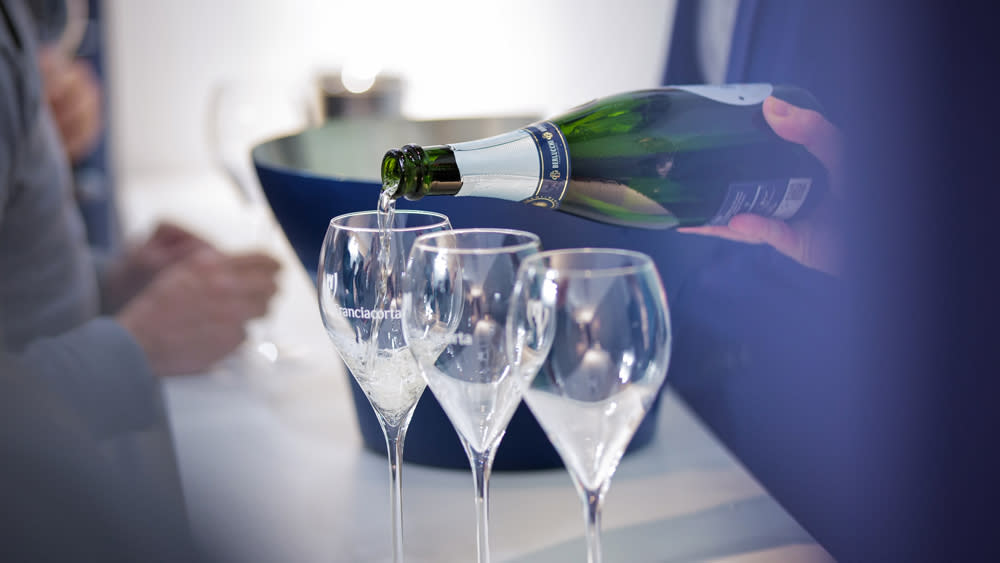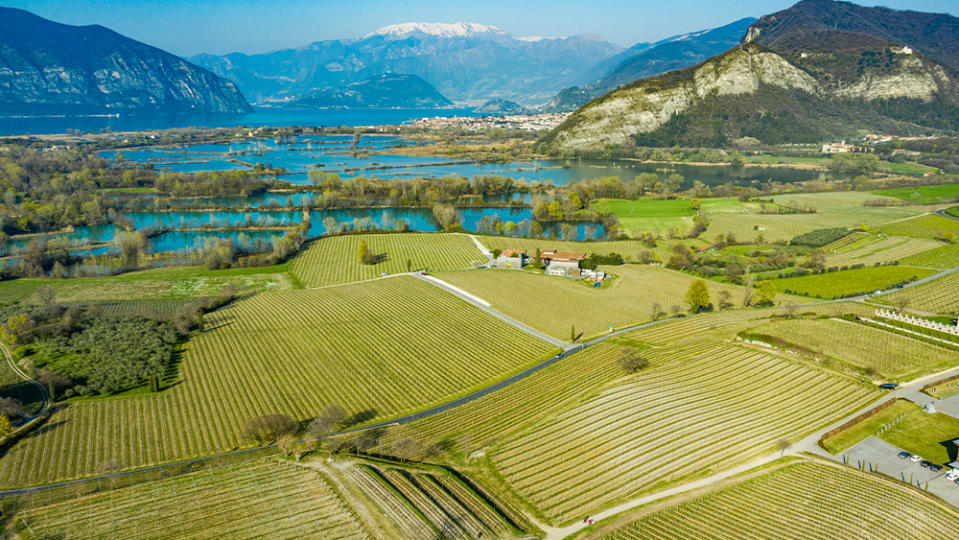Why This Italian Bubbly Is the Wine World’s Best-Kept Secret

This story is from an installment of The Oeno Files, our weekly insider newsletter to the world of fine wine. Sign up here.
Just a short distance from Milan, Italian sparkling wine region Franciacorta languishes in the long shadows cast by two better known but vastly different types of effervescent wine, Champagne and Prosecco. The first, which every wine lover knows is only produced in the Champagne region of France, is the luxurious standard-bearer for sparkling wine around the world, while the second—which, like Franciacorta, also hails from Northern Italy—is now the planet’s most popular style of fizzy wine. Italian sparkling is often lumped into one category, unfortunately thought of as cheap and cheery, but that is not the case at all. We are here to tell you that Franciacorta deserves a little R-E-S-P-E-C-T!
More from Robb Report
How to Make a Kir Royale, a Bright Champagne Cocktail With a Blackcurrant Twist
This New 8-Night Road Trip Through the Italian Countryside Was Inspired by the 'Ferrari' Movie
Let’s start with the rules: Made using the same grapes and in the same style as Champagne, Franciacorta has even stricter regulations for aging than its French counterpart. For example, non-vintage Franciacorta must be aged a minimum of 18 months, while NV Champagne must age in the bottle for a minimum of 15 months, including 12 of those on the lees. Furthermore, non-vintage rosé Franciacorta and the style known as Satèn (more on that later) must be aged for 24 months; meanwhile, there is no additional time stipulated for rosé Champagne to age. Vintage Franciacorta is required to be aged for 30 months as compared to Champagne’s 36 months, but Franciacorta’s regulations include a higher quality level, Riserva, which is always a vintage wine and must be aged for 60 months.
Now let’s get to the grapes: Unlike its native counterparts Prosecco (made with indigenous grape Glera) or Moscato d’Asti, Italy’s famed sparkling Moscato, Franciacorta is produced using Chardonnay, Pinot Nero, and Pinot Bianco, the last two being the Italian names for Pinot Noir and Pinot Blanc. These are three of the six allowable grapes in Champagne, and Franciacorta gets its sparkle from what is known in the wine world as the méthode champenoise or méthode traditionelle, which the Italians call metodo classico or metodo tradizionale.

Same grapes, same style, but from a distinct region in a different country. So why hasn’t it taken our shores by storm? Almost 90 percent of Franciacorta is sold within Italy, and only a small fraction of the remaining amount that is exported globally makes it into the United States. Considering its rarity, it should be selling for loftier prices, but several of the higher-end versions fetch between $50 and $100 at retail. We are not here to tell you that Franciacorta is a lower-priced alternative to Champagne but rather the wine world’s best-kept secret.
One of the brands with a strong presence in the U.S. market, Ca’ del Bosco, produces two top-tier offerings, Ca’ del Bosco Franciacorta Riserva Annamaria Clementi and Ca’ del Bosco Franciacorta Vintage Collection Satèn, which sell for $100 and $75, respectively. Named for proprietor-winemaker Maurizio Zanella’s mother, the 2014 Riserva Annamaria Clementi is a blend of Chardonnay, Pinot Noir, and Pinot Blanc from the winery’s estate vineyards that is matured on the lees for eight years and receives no additional dosage at disgorgement. “Satèn is a type of Franciacorta obtained from white grapes only; it is the blanc de blancs of the territory,” Zanella tells Robb Report. “The atmospheres of pressure, lower than other Franciacortas, contribute to soft, silky bubbles. It is certainly the most delicate and elegant Franciacorta.” The current vintage, 2018, is made with Chardonnay and Pinot Blanc and aged on the lees for four years after primary fermentation in small oak barrels.
Ricci Curbastro Franciacorta Dosaggio Zero Millesimato Gualberto, a blend of about 70 percent Pinot Noir and 30 percent Chardonnay, receives no additional sugar when disgorged, hence the words “dosaggio zero” in its name. Gualberto Ricci Curbastro, winery co-CEO, explains that “its dryness is compensated by a full body and an elegant acidity that is the result of a long aging on lees.” He points out that the wine, which has a suggested price of $93, is made with up to 15 percent of Franciacorta wines that have been aged for eight to 10 years in magnum bottles on the lees. “This process was developed in our estate 20 years ago and now is recognized among the authorized practices of the appellation,” he says. “The Dosaggio Zero Gualberto also ages over nine years to achieve all the elegance and freshness of a Franciacorta riserva.”

Several other Franciacortas have caught our attention recently, including Barone Pizzini 2011 Franciacorta Riserva Bagnadore, which sells for $90, and Bellavista Franciacorta Brut Millesimato Teatro alla Scala, which fetches $53. Made with Chardonnay, the Barone Pizzini 2011 was aged 70 percent in barrel and 30 percent in steel tanks before aging 70 months in bottle on the lees. “The long aging on the lees enhances complexity, aromas, and flavors,” CEO Silvano Brescianini says. “The 2011 harvest was one of the best in the last years and a riserva of this vintage could have a very long life.”
While it is drinking gorgeously now, with beautiful apple, pear, and brioche flavors mingling with full mouthfeel and bold acidity, the wine could add more layers of complexity with up to eight more years in cellar. Named for the famous opera house founded in 1778 in the center of Milan, Bellavista’s Teatro alla Scala offers fine perlage, a full, creamy texture, and flavors of citrus, green apple, orange blossom, and slivered almonds. Francesca Moretti, Bellavista’s winemaker, explains that each year on December 7, the feast day of Milan’s patron saint, Sant’Ambrogio, the new season opens at Teatro alla Scala with a premiere. She proudly continues, “Since 2004, the year in which the opera house reopened after lengthy restoration work, Bellavista has had the honor of being part of this ritual.”
Like all sparkling wine, Franciacorta deserves to be served at more than just special occasions. Arturo Ziliani, CEO and winemaker at Berlucchi, who is the man behind, among other bottlings, Berlucchi 2016 Guido Franciacorta Nature Millesimato ’61 (suggested price $73), likes the flexibility of pairing possibilities. This is not a vintage 1961 wine but is rather named in homage to the first vintage released by founder Guido Berlucchi. Made with Chardonnay and Pinot Noir and matured sur lie, it possesses a rare combination of freshness and depth, with what Ziliani refers to as “bright acidity and a crisp, clean profile.” With that in mind, he suggests pairing it with raw seafood such as oysters, shrimp, or sushi, explaining, “The acidity of the wine will complement the freshness of the seafood.” On the other hand, he also likes to pour it with fuller textured and richer dishes, pointing out, “A creamy Parmesan risotto can work well with the texture and flavor profile of the wine. The richness of the risotto can be balanced by the acidity of the sparkling wine, creating a harmonious pairing.” With possibilities like this at lunch or dinner, it’s time we let the Franciacorta secret out.
Want more exclusive wine stories delivered to your inbox every Wednesday? Subscribe to our wine newsletter The Oeno Files today!
Best of Robb Report
Why a Heritage Turkey Is the Best Thanksgiving Bird—and How to Get One
The 10 Best Wines to Pair With Steak, From Cabernet to Malbec
Sign up for Robb Report's Newsletter. For the latest news, follow us on Facebook, Twitter, and Instagram.

